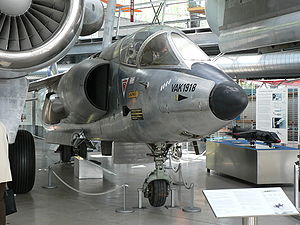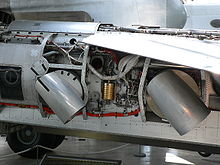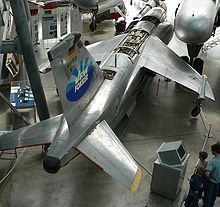VFW VAK 191B Video - Picture

|
|
VFW VAK 191B
VAK 191B

Picture - VAK 191B displayed next to a Dornier Do 31 transport
Role: VTOL strike fighter
Manufacturer: Vereinigte Flugtechnische Werke
First flight: 20 September 1971
Status: Retired
Primary user: Luftwaffe
Number built: 3
The VFW VAK 191B was an experimental German VTOL nuclear strike fighter of the early 1970s. Designed and built by the Vereinigte Flugtechnische Werke (VFW) it was intended to lead to a replacement for the Fiat G.91.
Design and development
The VAK 191B was produced by the German company Vereinigte Flugtechnische Werke (VFW). Initially, Fiat of Italy was also involved but dropped out in 1967, though it remained as a major sub-contractor. VAK was the abbreviation for Vertikalstartendes Aufklx¤rungs und Kampfflugzeug (V/STOL Reconnaissance and Strike Aircraft).

Picture - Rotating nozzle detail
Propulsion was provided by a Rolls-Royce/MAN Turbo RB.193-12 vectored thrust engine for both lift and cruise which was augmented by two vertical lift engines.
The program was begun in 1962 to replace the Fiat G.91 ground attack fighter with a VTOL aircraft but NATO requirements changed and it became a technology demonstrator. Three VAK 191B aircraft were flown in the flight test program between 1970-1975 making 91 flights. The first hovering flight was made in Bremen on 20 September 1971. The first transition from vertical flight to horizontal and vice versa was achieved on 26 October 1972 in Munich. The prototypes were used to test some of the concepts in what was to become the Panavia Tornado programme, including 'fly-by-wire' technology.
The VAK 191B was similar in concept to the British Harrier, but was designed for a supersonic dash capability (Mach 1.2-1.4) at medium to high altitudes. It was judged that having a single engine would create too much drag, but the two lift engines were dead weight in cruise, and the small cruise engine gave a poor thrust to weight ratio. It also had very small highly loaded wings. By contrast, the Harrier had a much higher thrust to weight ratio, it was effective as a dogfighter, and had larger wings which were put to good use in rolling short takeoffs.
Aircraft on display
An example of the VAK 191B can be seen at the Deutsches Museum Flugwerft Schleissheim at OberschleixŸheim near Munich.
The second remaining VAK 191B is part of the Wehrtechnische Studiensammlung (Military technical collection) at Koblenz, Germany.
The third VAK 191B was reported as being put into storage in 1976. Its current location is at Airbus in Bremen.
Operators
Germany
Luftwaffe
Specifications (VAK 191B)

Picture - VAK 191B from above
Data from {X-Planes and Prototypes}
General characteristics
Crew: 1
Length: 16.40 m (53 ft 7 in)
Wingspan: 6.16 m (20 ft 3 in)
Height: 4.30 m (14 ft 1 in)
Wing area: 19 m² (204.44 ft²)
Empty weight: 5,562 kg (12,236 lb)
Loaded weight: 8,507 kg (18,715 lb)
Max takeoff weight: 9,000 kg (19,800 lb)
Powerplant:
1x— Rolls-Royce/MAN Turbo RB.193-12 lift/cruise turbofan, 45.2 kN (10,150 lbf)
2x— Rolls-Royce RB162-81 F 08 lift turbojet, 26.5 kN (5,587 lbf) each
Performance
Maximum speed: 1,108 km/h (594 knots, 684 mph)
Range: 400 km (216 nm, 246 mi)
Service ceiling: 15,000 m (49,200 ft)
VFW-614
Comparable aircraft
EWR VJ 101
Hawker Siddeley Harrier
Hawker Siddeley P.1154
Hawker Siddeley P.1127
Yakovlev Yak-38
Bibliography
Jackson, Paul A. German Military Aviation 1956-1976. Hinckley, Leicestershire, UK: Midland Counties Publications, 1976. ISBN 0-904597-03-2.
VFW VAK 191B Pictures
More aircraft.
Source: WikiPedia